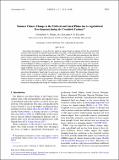| dc.contributor.author | Nikiel, Catherine A. | |
| dc.contributor.author | Eltahir, Elfatih A. B. | |
| dc.date.accessioned | 2020-05-28T18:13:48Z | |
| dc.date.available | 2020-05-28T18:13:48Z | |
| dc.date.issued | 2019-09 | |
| dc.date.submitted | 2019-02 | |
| dc.identifier.issn | 0894-8755 | |
| dc.identifier.issn | 1520-0442 | |
| dc.identifier.uri | https://hdl.handle.net/1721.1/125562 | |
| dc.description.abstract | Agricultural development is among the most significant forms of land-use change globally. In central North America it has consisted of cropland expansion in the early 1900s, yield intensification starting in the 1930s, and the development of large irrigated areas beginning in the 1950s. The area of this study encompasses the Midwest and Great Plains of the United States not only because significant agricultural change has occurred here but also because of the significant cooling (warming hole) there in the midcentury. This study investigates the relative contribution of agricultural development and greenhouse gas (GHG) emissions on the observed patterns of regional changes in summer temperature, precipitation, and evapotranspiration using a long-term twentieth-century reanalysis dataset (CERA-20C) as boundary conditions for simulations with the MIT Regional Climate Model (MRCM). Temperatures in the Great Plains (338–438N, 958–1098W) and the Midwest (388–488N, 828–1098W) would have been significantly higher in the second half of the twentieth century without the influence of agricultural development, largely due to an increase in evaporative cooling. The simulations of precipitation changes reflect a significant influence of global SST teleconnections at decadal time scales. Numerical simulations also demonstrate the competing effects of cropland expansion and yield intensification on shaping the observed pattern of increases in precipitation. Ultimately, a combination of agricultural development and decadal variability of global sea surface temperatures (SST) explains most of the observed variability of summer temperature and precipitation during the twentieth century over central North America. | en_US |
| dc.language.iso | en | |
| dc.publisher | American Meteorological Society | en_US |
| dc.relation.isversionof | http://dx.doi.org/10.1175/jcli-d-19-0096.1 | en_US |
| dc.rights | Article is made available in accordance with the publisher's policy and may be subject to US copyright law. Please refer to the publisher's site for terms of use. | en_US |
| dc.source | American Meteorological Society | en_US |
| dc.title | Summer Climate Change in the Midwest and Great Plains due to Agricultural Development during the Twentieth Century | en_US |
| dc.type | Article | en_US |
| dc.identifier.citation | Nikiel, Catherine A. and Elfatih A. B. Eltahir et al. "Summer Climate Change in the Midwest and Great Plains due to Agricultural Development during the Twentieth Century." Journal of Climate 32, 17 (September 2019): 5583-5599. © 2019 American Meteorological Society | en_US |
| dc.contributor.department | Parsons Laboratory for Environmental Science and Engineering (Massachusetts Institute of Technology) | |
| dc.relation.journal | Journal of Climate | en_US |
| dc.eprint.version | Final published version | en_US |
| dc.type.uri | http://purl.org/eprint/type/JournalArticle | en_US |
| eprint.status | http://purl.org/eprint/status/PeerReviewed | en_US |
| dc.date.updated | 2020-05-22T16:53:17Z | |
| dspace.date.submission | 2020-05-22T16:53:21Z | |
| mit.journal.volume | 32 | en_US |
| mit.journal.issue | 17 | en_US |
| mit.license | PUBLISHER_POLICY | |
| mit.metadata.status | Complete | |
